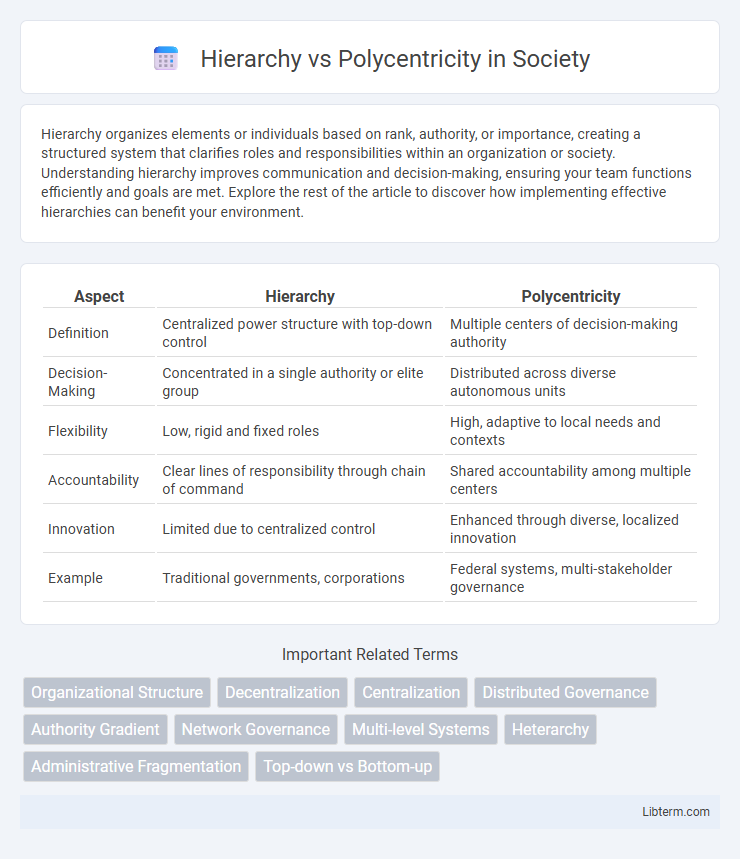Hierarchy organizes elements or individuals based on rank, authority, or importance, creating a structured system that clarifies roles and responsibilities within an organization or society. Understanding hierarchy improves communication and decision-making, ensuring your team functions efficiently and goals are met. Explore the rest of the article to discover how implementing effective hierarchies can benefit your environment.
Table of Comparison
| Aspect | Hierarchy | Polycentricity |
|---|---|---|
| Definition | Centralized power structure with top-down control | Multiple centers of decision-making authority |
| Decision-Making | Concentrated in a single authority or elite group | Distributed across diverse autonomous units |
| Flexibility | Low, rigid and fixed roles | High, adaptive to local needs and contexts |
| Accountability | Clear lines of responsibility through chain of command | Shared accountability among multiple centers |
| Innovation | Limited due to centralized control | Enhanced through diverse, localized innovation |
| Example | Traditional governments, corporations | Federal systems, multi-stakeholder governance |
Understanding Hierarchy: Definition and Key Features
Hierarchy is an organizational structure characterized by a clear chain of command where authority flows from top-level management to lower levels, ensuring control and coordination across departments. Key features include well-defined roles, centralized decision-making, and formalized rules that govern interactions and responsibilities. This rigid framework supports efficient supervision and accountability but may limit flexibility and swift adaptation.
Defining Polycentricity: Concepts and Principles
Polycentricity refers to the organization of urban or institutional systems characterized by multiple centers of decision-making authority that operate independently yet collaboratively within a shared framework. This concept emphasizes decentralization, local autonomy, and networked governance, contrasting with hierarchical structures where authority is concentrated at the top. Key principles of polycentricity include the coexistence of overlapping jurisdictions, mutual adjustment mechanisms, and the capacity for self-organization among diverse actors.
Historical Evolution of Hierarchical Systems
Hierarchical systems have evolved from rigid, top-down structures in ancient civilizations, such as the Egyptian pharaohs' rule and Roman military command, into more complex bureaucracies during the Industrial Revolution. These systems prioritized centralized authority and clear chains of command to enhance control and efficiency within organizations. Over time, hierarchical models adapted to accommodate growing organizational sizes and complexities, leading to formalized roles and standardized procedures.
The Rise of Polycentric Models in Modern Governance
Polycentric models in modern governance emphasize multiple centers of decision-making authority, contrasting with traditional hierarchical structures focused on top-down control. This shift fosters greater adaptability, local autonomy, and stakeholder participation in urban planning, environmental management, and public services. Empirical studies show polycentric systems improve resilience and innovation by enabling diverse institutions to collaborate across scales.
Key Differences Between Hierarchy and Polycentricity
Hierarchy organizes authority in a top-down structure where decision-making flows from higher to lower levels, ensuring clear control and standardized processes. Polycentricity distributes authority across multiple centers or entities, allowing for localized decision-making and greater adaptability to diverse environments. The key difference lies in hierarchy's centralized control versus polycentricity's decentralized governance, impacting organizational flexibility and responsiveness.
Advantages and Disadvantages of Hierarchical Structures
Hierarchical structures offer clear chains of command, facilitating efficient decision-making and accountability, which enhances organizational control and reduces ambiguity in roles. However, they may lead to slower communication flow and reduced flexibility, potentially stifling innovation and employee autonomy. The rigid framework can cause delays in adapting to market changes and may increase bureaucracy, impacting overall organizational agility.
Benefits and Challenges of Polycentric Approaches
Polycentric approaches offer enhanced local autonomy, fostering innovation and responsiveness by empowering multiple decision-making centers within organizations or governing bodies. This structure reduces the risks of central bottlenecks, facilitates context-specific problem-solving, and promotes diversity in policy implementation. Challenges include potential coordination difficulties, inconsistencies across units, and the complexity of maintaining effective communication and collaboration among distributed entities.
Case Studies: Hierarchy in Traditional Organizations
Case studies of hierarchy in traditional organizations reveal rigid structures with clearly defined roles and top-down decision-making processes. These organizations often emphasize control, consistency, and efficiency through centralized authority, enabling streamlined communication but limiting flexibility. Examples include multinational corporations like General Electric and Toyota, where hierarchical management supports operational stability and coordinated strategy execution across global divisions.
Real-World Examples of Polycentric Systems
Polycentric systems manifest prominently in urban governance models such as the metropolitan governance structures of the San Francisco Bay Area, where multiple local governments collaborate yet retain autonomy, enhancing responsiveness to local needs. Another real-world example includes the federal system of governance in Switzerland, where cantonal authorities exercise significant powers alongside the central government, promoting balanced regional development. These polycentric arrangements contrast hierarchical models by enabling decentralized decision-making and fostering innovation through diverse institutional actors.
Choosing Between Hierarchy and Polycentricity: Factors to Consider
Choosing between hierarchy and polycentricity depends on factors such as organizational size, geographic dispersion, and the need for centralized control versus local autonomy. Hierarchy suits organizations requiring clear authority, standardized processes, and efficient decision-making, especially in stable environments. Polycentricity benefits multinational corporations by promoting local responsiveness, cultural adaptation, and decentralized decision-making in diverse markets.
Hierarchy Infographic

 libterm.com
libterm.com